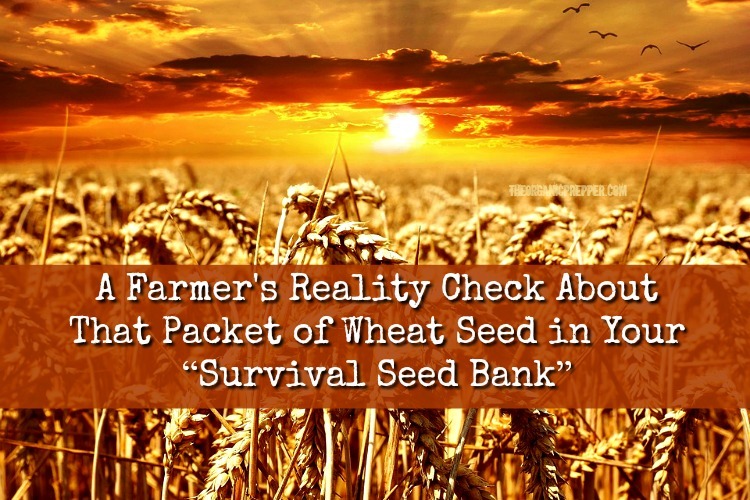If you're new here, you may want to subscribe to my RSS feed. Thanks for visiting!
By Scott Terry
Originally Published at Backwoods Resistance
I’ve never been a fan of the pre-made “survival seed banks” that are sold to preppers for a variety of reasons. I won’t get into all the reasons today, but some time back I was sent a sample of one company’s seed collection that was marketed as a “bug out seed bag” or some such thing. While the quality of the seeds was probably better than average, one thing that bugged me about it was that it proudly advertised it contained wheat seed. This particular mylar packaged bag of seeds contained one garden sized packet of winter wheat seed. The sad thing is that some poor soul who doesn’t know any better is walking around thinking they are going to grow a meaningful amount of wheat from this tiny packet. This is not the case.
Let’s look at reality for a moment…
On average, there are 22 seeds per head and 5 heads per wheat plant. This works out to about 110 seeds per plant. So let’s say for sake of argument that the packet has 50 seeds in it. If it all germinates, survives the winter, and makes a harvest-able crop you are looking at a yield of about 5,500 kernels of wheat. On average it takes 15,000 wheat kernels (or seeds) to make a pound. That’s right folks, that packet of seed MIGHT produce just under a half a pound wheat. How many loaves of bread do plan on eating?
Real Post SHTF Wheat Production
If you are serious about growing your own wheat for the sake of your family’s survival, you need to think a lot bigger than a seed packet. The US average yield for wheat is about 47 bushels per acre. A bushel of wheat weighs 60 lbs. Keep in mind these figures are for commercial wheat production using modern fertilizers and weed control measures. I would expect the average yield in a post SHTF world will be much lower, probably closer to 30 bushels per acre.
Most reliable resources figure you need about 300 lbs of wheat per adult for a years supply of survival food but it is also been figured that the average American on a “standard American diet” consumes 1996 lbs of wheat a year. I’ll let you decide how much you need for your family, but a family of 4 should probably have about 900 lbs of wheat for a year’s supply at a minimum.
So the next question is “how much do I need to plant”. Let’s stick with a family of 4 for our example. You should plan to seed about 60 lbs to the acre. This should yield you a harvest of about 1800 lbs to the acre (using our 30 bushel to the acre estimate from above). So you should be able to get by planting 1/2 an acre which will require about 30 lbs of seed.
You also need to have a plan for tillage, harvest, processing, and storage of this wheat crop. I will visit these topics in a future article. The import thing right now is that you understand just how much land and seed is required to grow wheat for your family and you aren’t under the impression that you can do it with a seed packet.
About the Author
Scott Terry is the author of Backwoods Resistance. His website covers a wide range of topics from current events, history, preparedness, survival, and strategy.
He is a full-time farmer by trade, a political activist, a lover of liberty and a backwoodsman. He has spent a great deal of time in the woods, from his native northeastern US to the Rocky Mountain state. He also ran a trap line in Alaska’s interior where the base of operations was 24 miles from the nearest highway. Scott enjoys teaching others survival and preparedness skills and he refuses to sit idle and allow our liberty, culture and property to be destroyed by globalism, collectivism and the New World Order. He loves the freedom and lifestyle of the rural life and want to preserve it and help you reach it as well.
Scott’s motto is summed up best… Remember the past. Prepare for the future. Never Submit.
You may also enjoy these articles:
Here’s Why a Prepper Homestead May Not Be a Good Plan for Survival
How Our Homegrown Thanksgiving Went Horribly Wrong
Selco’s SHTF Reality Check: 5 Deadly Mistakes That Preppers Are Making


















You are absolutely correct about these seed banks, however I have found one useful thing which is that I use them as “samples” to test out which vegetables I want to grow going forward. I am spending time now growing and testing various plants to see which ones produce the most with the least amount of time, effort and resources. At this point the vegetable plant that makes since to me are fast growing root vegetables such as radishes and beets along with things like snow peas which growing relatively quickly. God forbid that you have to start a garden from scratch after SHTF…that’s not going to be an easily proposition.
That’s the kind of testing I am doing. The seeds banks often include seed that cannot possibly be grown in your area so experimenting now is a good thing.
Do not forget to test the harvesting of seeds for next year crop. In a SHTF situation you will have to produce those as well and they might be valuable too.
Mr. Scott Terry is quite correct, the average packet of seeds of wheat and a few other crops will barely feed a family of 4. In fact, it will barely feed the critters that raid your garden. Then average person will grow a small, lets call it what it really is, sample of vegetables and grains to see if they can produce the results necessary to survive on. The average garden grower is limited by the amount of land that they can or will dedicate into having a garden. The average gardener wouldn’t know how to harvest most grain crops like wheat, barley, buckwheat and so on. The best they can do is to grow corn and pray that the ears of this crop become pollinated enough to produce a nice crop of 4th of July corn.
Seed company’s know this and pander their sales toward this flaw. In fact, most seed packets are filled with no more than 25 seeds, should the seeds are big, or by the quarter ounce, which is ever more profitable for the company. Back in the 1960’s a seed packet had enough seeds for two seasons. Not any more. It is all geared towards profitability, the less they can sell you at a higher rate of profitability the bigger the smile the seed companies have. If you wish a decent crop chances are you will need to purchase more than one packet.
So, some poor ignorant prepper takes it upon himself to grow a crop that he can not sustain himself or his family on; then it is on him. However, if this prepper wanted to experiment on whether he can grow a grain crop, like wheat, then why not give this guy a sample packet of wheat? It is after all good business. There is nothing on the packet stating that you will need x amount of seeds or x amount of wheat produced per volume of seeds in the packet. After all, it all falls back on buyer beware, doesn’t it? It is up to the customer to decide if this product is for him.
So where does this leave us? It leaves the average prepper to do his home work. Know what product will produce the greatest amount of product to assist in the growers survival. Crops like tomatoes, cucumbers, carrots will always be a big hit. One packet of seeds is enough for a season of bounty. But to grow a grain crop, you are talking about some serious farming.
It is one thing to test your skills and abilities, but, know your limitations and skill level. Do your homework and know what you are doing before you do it. It will save you a lot of time, energy, effort, money, aggravation, frustration, and disappointment.
Also remember acorns can be grounded into flour, probably could mix the two. I probably should try this out…….
Thank you for this article! While have several of those “seed banks” in a cool dark place, I am just a vege and fruit gardener so I am ignorant on grains. Next spring I plan to experiment with wheat and oats in small amounts just to learn how to grow and harvest them. I usually get my seeds from our local feed store as they only carry what grows well in our location. With your explanation I can now figure out how much seed I need to get.
A great article from a REAL realist. I applaud you, sir.
You may want to check out Gene Logsdon’s Small Scale Gain Raising.
These and other seed banks should only be supplemental and not the plan
Excellent article. Preppers are becoming a decent sized business segment and everyone wants in on the action, and so buyer beware is more and more important. If you do not train now, when things get bad, you will not be able to succeed. This doesn’t just apply to firearms, but to all preps. Growing a garden or a patch of grain isn’t as sexy or fun as going shooting, but is every bit as important. For grain, I would recommend https://en.wikipedia.org/wiki/Einkorn_wheat if you can get it. Once again this website proves how valuable it is in getting people to think intelligently.
If you live near an amish community you can often find an amish store, they might have heirloom wheat in bulk at reasonable cost. Better would be to grow your own than not have wheat at all, but hopefully there will be local farmers with experience, seed, and land pitching in when shtf. Of course the farmer will want compensation for his efforts so have something to trade.
many years ago,in the supermarket,somehow we got on the topic of a loaf of bread and 1 pound of flour aaaand how you planted the seeds and prayed,then the harvest, then the threshing on and on and back then all by hand.
of course we couldn’t remember what amount of wheat was needed per pound but knew to respect that loaf of bread/5 pound bag of flour.
The point of fact should be: Everyone should have wheat stored as berry in their food storage, plus some wheat in their seed storage. The food storage wheat should supply the family with wheat for a few years, all the while food storage wheat, and the wheat seed storage is planted and replanted to populate the seed wheat, to a usable amount for ‘future’ wheat planting and storage. The hardest part is to pick the correct type of wheat for your area. Some areas won’t grow wheat.